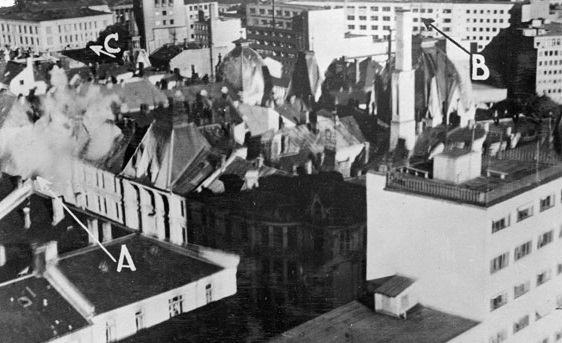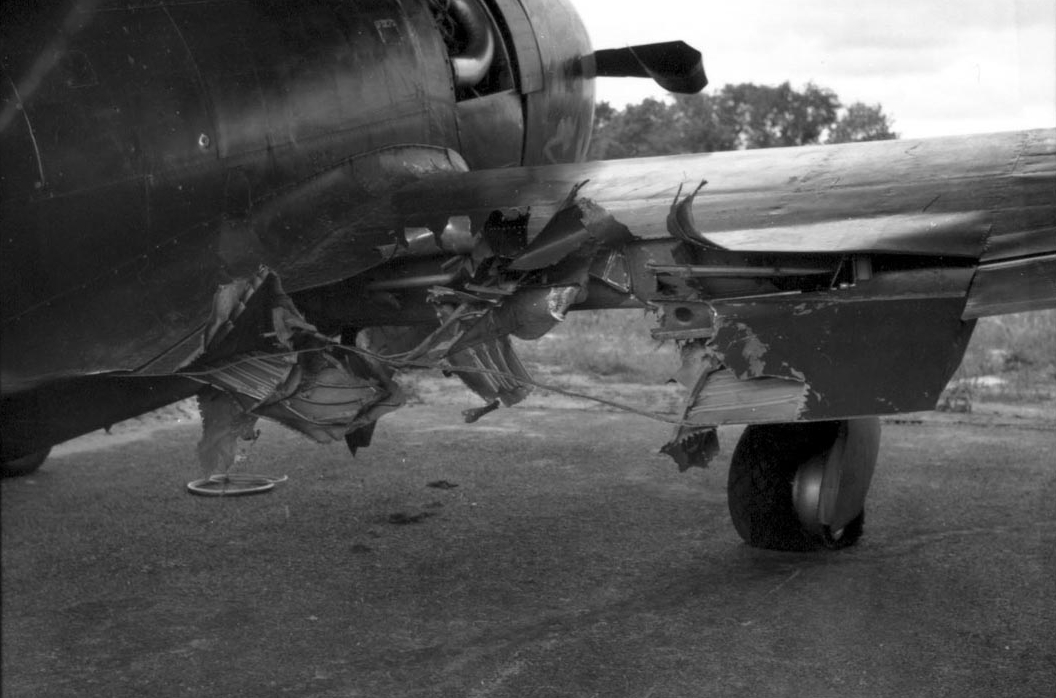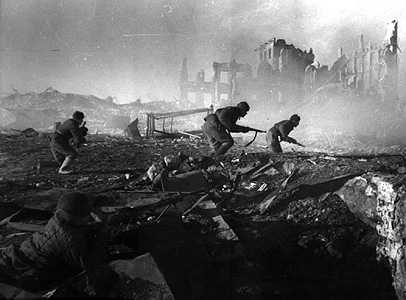The War in the Air
The War Illustrated, Volume 6, No. 139, Page 264, October 18, 1942.
The strategic and tactical employment of air forces for the prosecution of war on land has at present reached a stage of stabilization; although their methods may differ slightly the aim of the use of air power is, with all the belligerents, alike.
In Western Europe British air power is employed mainly to deplete the enemy's war resources in materials and plant. The shooting-up of locomotives by cannon-firing fighters in the occupied area of France and the Low Countries coincides with the German demand for railway engines for military purposes and with Bomber Command's heavy night raids on the locomotive-building plants of Kassel; during this period the American Army Air Force in the United Kingdom raided railway yards in France and Holland by day. It will be clear the these interlocking activities are co-ordinated as the result of preliminary intelligence reports.
But, in the main, the ever-lengthening activities of Bomber Command are directed to the diminution of the submarine menace to the sea communication lines of the United Nations; while Coastal Command is almost entirely engrossed in the more direct pursuit of this object in a hunt for U-boats on patrol.
The present small-scale retaliatory German air attacks against the United Kingdom appear to be linked with their U-boat warfare; their object is apparently as much to attack the supplies for the population as to attack war objectives. That is the most rational explanation of the types of air attacks which the Luftwaffe has made against the United Kingdom during recent months.
Thus it can be said that more than fifty per cent of the air activity over Western Europe is directly concerned with the submarine war. At the same time, air pressure upon Germany has far-reaching effects, for, its peak level, other war industries must be depleted to make good the losses sustained by the heavy industries working on the German submarine-building programme. So, indirectly, Allied air pressure on Germany and occupied Europe assist Russia by adding to the strain of German industrial effort; and it aids Russia directly by reducing German power to interfere with sea convoys bound for Russian ports.
Much of the sea-mining of German-controlled waterways is aimed at curtailing submarine activities, although it simultaneously affects German waterborne lines of surface communication.
When regarded in this light, it will be seen that the air war over Western Europe is a war of attrition whose results affect every theatre of war, every sea-lane and every ocean.
In the fighting zones aircraft concentrations are essential. In quiet periods there is a demand for continuous reconnaissance for intelligence purposes, and there is the need to maintain strategic bombing to endeavour to disorganize the enemy rear bases of supply and lines of communication. Although called strategic bombing, these operations are only strategic in the limited sense of their relation to the disposition of the land forces; by the use of the term "strategic" they are distinguished from the tactical operations which engage from the air the actual frontline or immediate reserve fighting units.
The employment of air power on the fighting fronts has acquired a stabilized technique, but the increasing use of bomber aircraft as army "artillery" and of fighter aircraft as armed "cavalry" has created as great a demand for air power for ground forces as the demand for gun-power in the Great War. Indeed, so great has this demand become among the German forces that it has outstripped the supply of aircraft which the Luftwaffe and German aircraft factories can produce. In consequence, some zones must be left relatively weak to make it possible to strengthen others. The battle for Stalingrad has absorbed a force of about a thousand first-line German aircraft, or about one-fifth of the total first-line strength of the Luftwaffe. That leaves Germany with about 4,000 first-line aircraft to cover the 2,000 miles' length of the Russian front, meet requirements in North Africa, the Mediterranean, Western Europe, and in the Battle of the Convoys. This is a tenuous force to cover such huge military requirements, and to that face alone can the people of the United Kingdom ascribe the relatively smallscale nature of the raids which they have suffered for many months.
 Gestapo H.Q., Oslo, was bombed on the afternoon of Sept. 25, 1942, by four Mosquitos, the new type of twin-engined light bomber now in service with the R.A.F. This brilliant attack, involving a round flight of about 1,000 miles, interrupted a speech which Quisling was making to a national assembly of his party, the Nasjonal Samling. Bombs from our aircraft rocked the University building where the meeting was being held. Sqdn. Ldr. D. A. G. Parry, D.S.O. And Bar (left), whose sixtieth raid it was, led the attack. This photo was taken from the first Mosquito: A, direct hit on Gestapo H.Q.; B. cupola from which our airmen saw the Nazi flag flying. C, the University building. Photo, British Official: Crown Copyright.
Gestapo H.Q., Oslo, was bombed on the afternoon of Sept. 25, 1942, by four Mosquitos, the new type of twin-engined light bomber now in service with the R.A.F. This brilliant attack, involving a round flight of about 1,000 miles, interrupted a speech which Quisling was making to a national assembly of his party, the Nasjonal Samling. Bombs from our aircraft rocked the University building where the meeting was being held. Sqdn. Ldr. D. A. G. Parry, D.S.O. And Bar (left), whose sixtieth raid it was, led the attack. This photo was taken from the first Mosquito: A, direct hit on Gestapo H.Q.; B. cupola from which our airmen saw the Nazi flag flying. C, the University building. Photo, British Official: Crown Copyright.
It is certain that his air situation is a serious one for Germany; her only way out is through the defeat of Russia. Hence the ferocity of the struggle in the great plains and among the foothills of the Caucasus.
It seems to me that in this present stage almost of equilibrium, in the total air war, three important developments are apparent. Two concern the technical development of aircraft. The first of these developments is the struggle for height of operation. The earliest air fighting in France took place mostly below 25,000 feet. Today air fighting takes place up to between 30,000 and 35,000 feet. The turbo-superchargers of the Fortress bombers have enabled them to operate above the most efficient fighting level of German fighter aircraft. Now Germany has applied the lessons. A new version of the Messerschmitt single-engined fighter, the 109G, has been reported from Russia; it has a service ceiling of about 41,000 feet; it is armed with three cannons and two machine-guns. A new version of the Junkers 86 bomber, fitted with two semi-diesel, turbo-supercharger Junkers engines, has been produced which can climb to within two or three thousand feet of 50,000 feet.
The employment of means to attain great heights will vitally affect the defence, for interceptors may be unable to reach the bomber's operating height fast enough to engage them, and, in addition, bombers flying in the rarefied atmosphere are likely to be considerably faster, and will travel above the effective level of fire of current anti-aircraft guns. But to give them full effect, means will have to be devised to enable the bombers to carry heavier loeads than are at present possible at such heights.
The second techincal development is the use of larger and heavier bombs. So far the R.A.F. is ahead of the world in dropping 8,000-lb bombs. But the latest Heinkel 177 heavy bomber can carry at least 8,000-lb bomb load, and it is to be expected that it will be converted to carry a bomb of that size for retaliatory purposes.
Carrying of greater loads and flying at greater heights are opposed conditions. British search for the first and German search for the second indicate to my mind determination to attack upon the part of the R.A.F., and endeavour to evade upon the part of the Luftwaffe. This is again a pointer to the changing conditions of the ratio of air power. At the same time the R.A.F. cannot ignore the value of the high altitude flight.
The third, and tactical, development is the increasing use of fighter aircraft to protect convoys when they are out of reach of landbased fighter protection. The Sea-Gladiators have already done well from carriers and from merchant-ships' catapults. They helped the Malta and the Murmansk convoys. Their work is as vital as that of the bombers who blast the submarines and mine enemy waters.
Previous and next article from The War in the Air
The War in the Air
The air war has raged without interruption over the Far East, in the Australasian zone, on the Russian front (where our Allies estimate that more than 3,000 enemy aircraft were destroyed during the tw
The War in the Air
After the conquest of North Africa and the capture of the Italian islands of Pantelleria, Lampedusa and Lampione in the Sicilian Narrows, a strange hush descended upon military operations over all Eur
Index
Previous article
I Was There! - 'We Will Stick it in Malta. We Will Win'
"It means a lot to us to know that you in England are not forgetting us. It helps us to take it when we know we are not fighting unnoticed." So writes our young Maltese correspondent, John Mizzi, in a
Next article
I Was There! - On the 13th Day I Killed and Ate a Seagull
This is the story told by Pilot Officer Holbrooke Mahn, 23-years-old American member of the Royal Canadian Air Force, who spent 14 days in a small dinghy in the North Sea following the crash of his Ha





